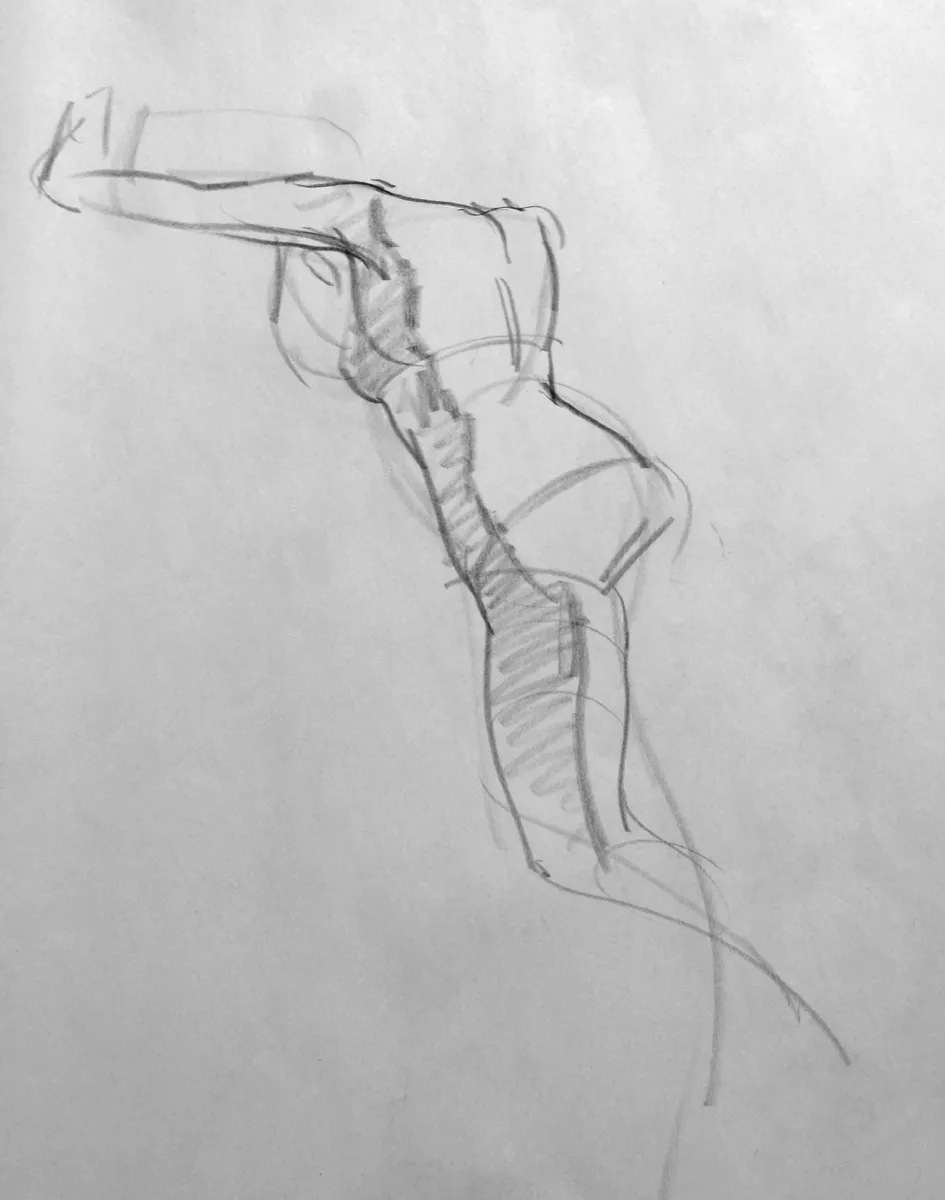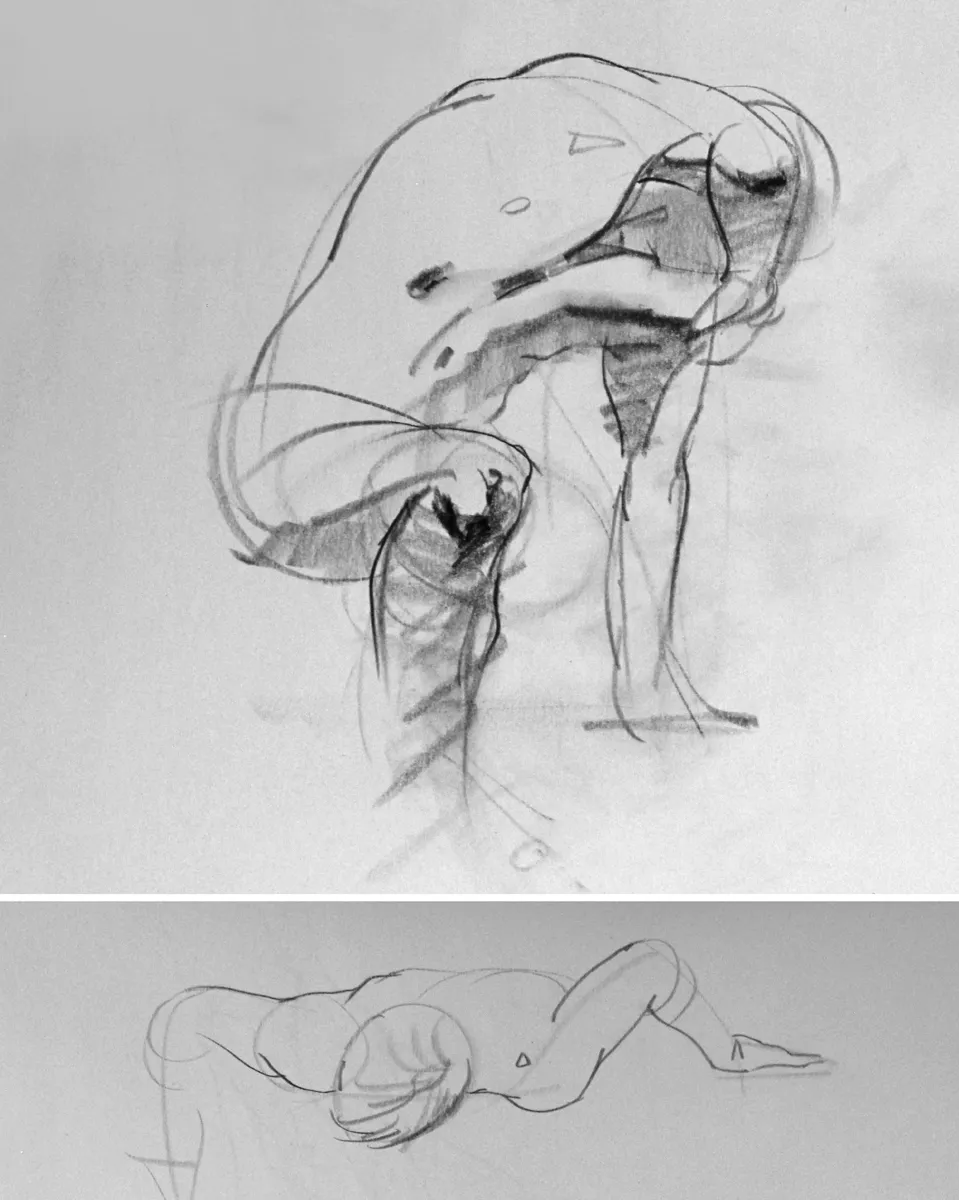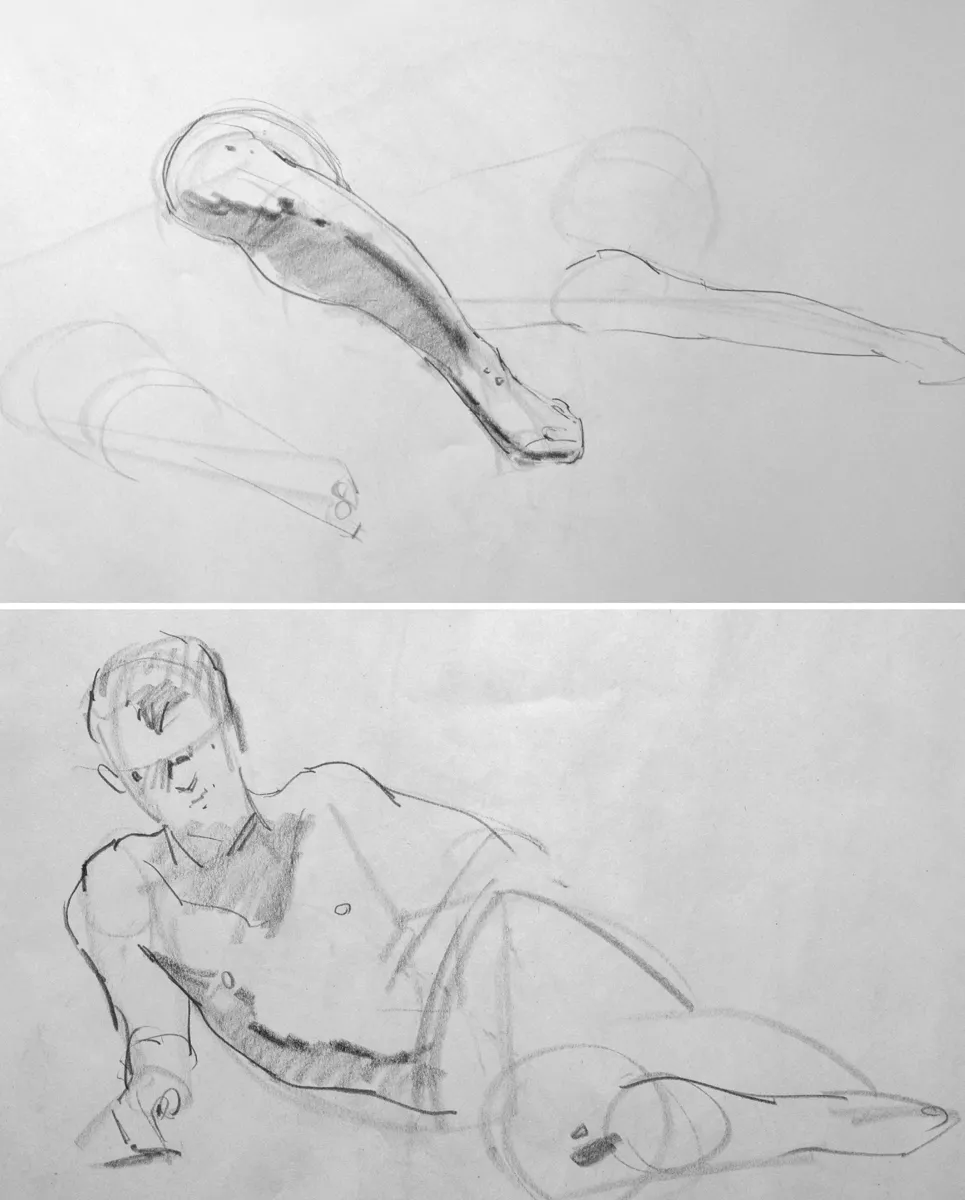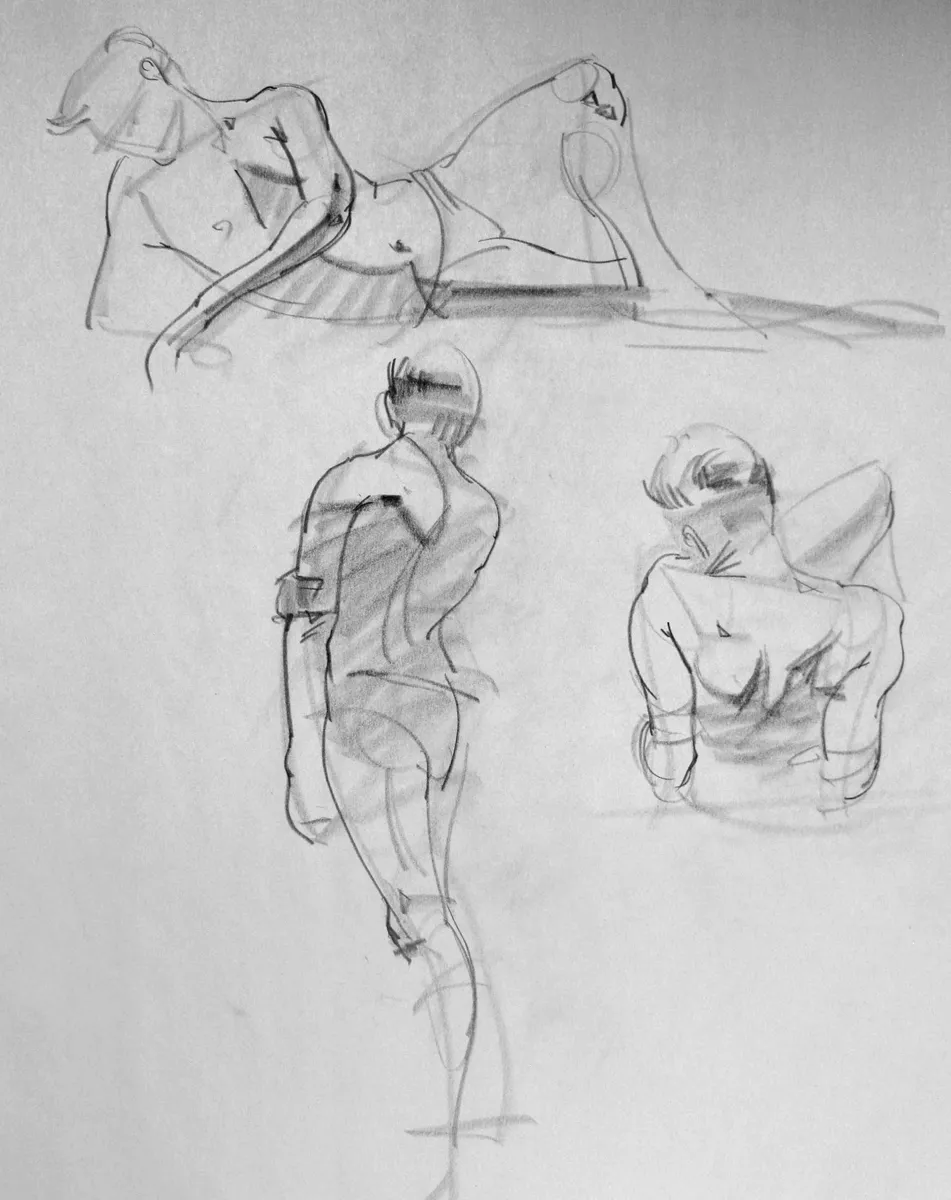
- 240 pages
- English
- ePUB (mobile friendly)
- Available on iOS & Android
eBook - ePub
About this book
The foundation of all figurative work is the life study of the human form. Sculptors, painters, and illustrators pull from the process to sharpen their observations, develop better hand-eye coordination, and improve their understanding and interpretation of what they see. Quick Pose: A Compilation of Gestures and Thoughts on Figure Drawing takes a look at the process, presenting first-rate examples and a brief but well-constructed text highlighted by more than 300 illustrations.
Author Erin Meads defines the quick pose as figure drawings that can be executed in less than 20 minutes. The majority of images in this book took less than five minutes to draw; their brevity encourages more dynamic poses from the model and challenges the artist to make quick decisions about what to include — and even more significantly, what not to include. Topics include symmetry, foreshortening, light and shadow, drapery, and other essential elements of figure drawing. Artists, art students, art teachers, and anyone who draws will appreciate these well-illustrated insights.
Author Erin Meads defines the quick pose as figure drawings that can be executed in less than 20 minutes. The majority of images in this book took less than five minutes to draw; their brevity encourages more dynamic poses from the model and challenges the artist to make quick decisions about what to include — and even more significantly, what not to include. Topics include symmetry, foreshortening, light and shadow, drapery, and other essential elements of figure drawing. Artists, art students, art teachers, and anyone who draws will appreciate these well-illustrated insights.
Frequently asked questions
Yes, you can cancel anytime from the Subscription tab in your account settings on the Perlego website. Your subscription will stay active until the end of your current billing period. Learn how to cancel your subscription.
At the moment all of our mobile-responsive ePub books are available to download via the app. Most of our PDFs are also available to download and we're working on making the final remaining ones downloadable now. Learn more here.
Perlego offers two plans: Essential and Complete
- Essential is ideal for learners and professionals who enjoy exploring a wide range of subjects. Access the Essential Library with 800,000+ trusted titles and best-sellers across business, personal growth, and the humanities. Includes unlimited reading time and Standard Read Aloud voice.
- Complete: Perfect for advanced learners and researchers needing full, unrestricted access. Unlock 1.4M+ books across hundreds of subjects, including academic and specialized titles. The Complete Plan also includes advanced features like Premium Read Aloud and Research Assistant.
We are an online textbook subscription service, where you can get access to an entire online library for less than the price of a single book per month. With over 1 million books across 1000+ topics, we’ve got you covered! Learn more here.
Look out for the read-aloud symbol on your next book to see if you can listen to it. The read-aloud tool reads text aloud for you, highlighting the text as it is being read. You can pause it, speed it up and slow it down. Learn more here.
Yes! You can use the Perlego app on both iOS or Android devices to read anytime, anywhere — even offline. Perfect for commutes or when you’re on the go.
Please note we cannot support devices running on iOS 13 and Android 7 or earlier. Learn more about using the app.
Please note we cannot support devices running on iOS 13 and Android 7 or earlier. Learn more about using the app.
Yes, you can access The Quick Pose by Erin Meads in PDF and/or ePUB format, as well as other popular books in Art & Art General. We have over one million books available in our catalogue for you to explore.
Information
GESTURE
GESTURE
The word gesture, in general terms, refers to the communication of an idea or feeling without the use of words. In a similar fashion, gesture drawing is simply capturing the fundamental nature or feeling of the pose with a minimal amount of mark making. Gesture is the energy in a pose, and drawings that lack energy also lack interest.
When I talk about gesture in my drawing class, I start out by asking the students what the word gesture, in terms of drawing, means to them. Most of them respond with the notion that it is a very quick drawing to get warmed up. I agree with that statement but would add that a gesture can also be an end in itself. I do not believe a gesture drawing is a mindless waving of the arm and the conté. Instead, I believe it is very mind involved. Gesture drawings help get the brain warmed up just as much as they help to reacquaint the artist with the figure and their drawing tool. For me, it takes a good 20-minute session or two before I feel like I am fully warmed up both mentally and physically.
Before putting the conté or charcoal on the paper, make sure to take in the pose. Try to make a plan of action before beginning. I would say nearly 90 percent of figure drawing happens in the artist’s head; the other 10 percent is in the hand. Each gesture should be thought out no matter the length of time given. Granted, there will not be ample time to sit, ponder, and meditate before the time is up and the model is on to a new pose. Quick decisions are required. My students are sometimes frustrated when they don’t work quickly enough. My answer for them is probably even more frustrating: “keep practicing.” The hard truth is that the more exposure a student has to the model and the more familiar they become with the human figure, the quicker they will be able to anticipate certain bends and stretches every human body takes. It is then that they are able to work quickly and concisely, and the fun begins.




CONFIDENT LINES
New students often begin drawing gestures with lots of short, sketchy marks because they are afraid of making one long continuous line that may end up being wrong. Working this way, however, creates stiffness in the figure and uses up precious time. Instead, push for making confident, deliberate lines that take less time and create a stronger, bolder statement. Students are afraid that these confident lines will be inaccurate and their proportions will be off. Unfortunately, this may happen, but usually just in the beginning. As stated before, the more practice, the better result. As students continue to draw, apply new ideas, and become more familiar with the figure, they eventually grasp proportion by eye and can check for accuracy as they draw (additional study of proportion, aside from drawing from life, such as in a sketchbook, would also surely help). In order to improve, it is necessary to let go of what we feel is safe. Playing it safe all the time will never lead to improvement. Nothing will change, and growth will not occur. Be willing to take a step backward in order to eventually leap forward. Be brave enough to let go of the need to establish precise proportions and instead, focus on confident line work and capturing an accurate feel or essence of the pose. While this may be scary and uncomfortable at first, eventually it will lead to drawings with believable proportions and beautiful, confident lines.





THE FIGURE AS A WHOLE
Often beginner students feel overwhelmed with trying to draw an entire figure in only one or two minutes. How is that even possible with all the intricacies and details of the human body? They are frustrated and perplexed, and they are correct in their bewilderment. There is no possible way to ever get all of the information comprising the human figure down on paper in one minute! Pick and choose what is important enough to include. Also decide what not to include (e.g., unnecessary information or anything that might distract the viewer from the real importance). This is called editing, and, as can be imagined, a lot of editin...
Table of contents
- Cover
- Title Page
- Acknowledgments
- Copyright Page
- Contents
- Foreword
- Introduction
- Gesture
- Weight & Balance
- Symmetry
- Foreshortening
- Light & Shadow
- Heads
- Drapery
- Final Thoughts
- About the Author
- Notes